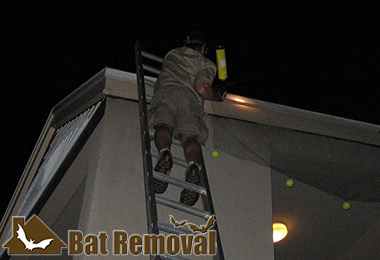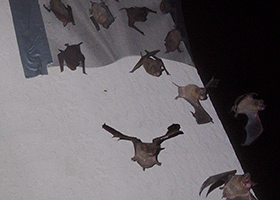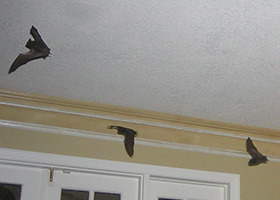Arkansas Bat Removal
Welcome to Arkansas Bat Removal! We are Arkansas bat removal specialists. It is important to know that bats are protected by Arkansas law, and are beneficial animals to have in the environment. We do not kill any bats during our bat removal process. Never hire a pest control company or anyone who says they are a Arkansas bat exterminator. For correct and effective bat removal, you want a company that specializes in humane bat colony extraction. Our process is not only the only legal method in Arkansas, but it is the most effective. We have a 100% success rate in our bat control process. We perform our industry-best 32-point inspection of your house or building, and seal shut all bat entry holes down to 1/4 inch as part of the removal process, during which we remove the colony via special one-way exclusion devices specific to your architecture. Once all bats are safely out, we permanenetly bat-proof the structure. We also provide guano (bat droppings) removal and decon. Click on our Arkansas Bat Control Prices page to find out more about our prices for bat control work. We work 24/7/365, and would love to talk to you about your bat problem. Call us any time at 501-205-0578 to discuss it, discuss our pricing, and if you wish, set up an appointment at your convenience, often same-day.

Arkansas Building and Attic Inspections

No-kill Arkansas Bat Extraction

Guano Cleanouts - Serving all of Arkansas
Call 24/7 to discuss your bat problem.
Same-day or next-day appointments.
32-point inspection of your property.
Written estimates for bat removal project.
Fully state licensed and insured.
Residential and commercial service
100% no-kill Arkansas bat extraction
Complete bat-proofing of your building
Compliance with all Arkansas, federal laws
Guano removal and attic decontamination
Our Service Range - 501-205-0578



Mexican Free-Tailed Bats Facts and Information
The Mexican Free-Tailed bats derived its name from the length of the bat's free tail that projects beyond the edge of its uropatagium. This feature grants the bath with incredible maneuverability. This is a native bat that is considered as one of the most populous species of bats in the North American region. It will build its colony that is composed of an overwhelming number of bats. It is also very particular with its habitat location which makes them vulnerable to urbanization and habitat destruction.
Appearance of the Mexican Free-Tailed Bats
The Mexican free-tailed bat is a medium-sized creature that is known for its fur that can have a variety of colors. The fur may range from reddish to gray shade. They have dark broad ears that are pointing forward. Their lips are wrinkled, and their tails extends beyond the membrane in their tail. They have narrow and long wings.
Diet
The diet of this bats is mostly comprised of insects especially the pests that can destroy crops. A large colony of the Mexican Free-Tailed bats can consume billions of insects per year. Even the small bat colony can help in managing the population of insects. This makes them a beneficial asset to the agricultural setting.
Habitat
Mexican Free-Tailed bats are primarily found in Mexico and the remaining parts of the North American continent. However, its distribution will not extend to Canada. The habitat of this bat will vary. You may find them on forested areas, agricultural places, and on desert regions. The primary requirement of this bat when looking for a possible habitat would be an excellent roosting place. Usually, they will find the cave an ideal place to establish the colony especially if it has a high insect population. They will also roost close to a source of water since water tend to attract the attention of insects.
Life Cycle
The baby Mexican Free-tailed bats will be born on the summer season. The roosting ground of this place will be different from the mother bats. They will choose the highest part of the cave where the temperature will be higher. The colony can be composed of thousands of other bats. The mother bats will be able to identify their baby through the unique call that it produces. The bats will have an estimated life span of 7-8 years. They will be devouring insects that is around three times of their overall body weight every night.
The Mexican free-tailed bats are perhaps one of the most social creatures in the planet. They will be gathering in large number. Compared to other types of bat, they do not belong in the endangered type of species.
While bats are known to control the population of harmful bats, they can also carry zoonoses such as histoplasmosis. You will not appreciate a visit from a colony of bats since their bat guano can accumulate fast. This will not only transmit diseases but can also cause structural damages. Dealing with this type of infestation can be stressful.

